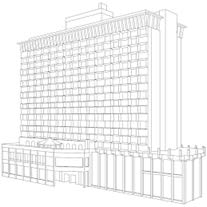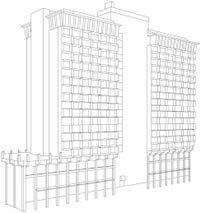
TTAB CONFIRMS THAT BUILDING DESIGN MARKS LACK OF DISTINCTIVENESS
In In re Palacio Del Rio Inc (Serial Nos 88412764 and 88437801), the Trademark Trial and Appeal Board (TTAB) has issued an opinion affirming the refusal of two building design mark applications by Palacio Del Rio Inc (PDR) – a subsidiary of Hilton Worldwide Holdings Inc.
Background:
Applicant PDR owns and operates a hotel of the same name situated along the famous River Walk in San Antonio, Texas. In May 2019 PDR filed applications for two building design marks for “hotel services; provision of conference, exhibition, and meeting facilities” in Class 43. The marks consisted of minimalist line-drawing representations of the Palacio Del Rio hotel itself, each representing one side of the structure from a diagonal angle:
Serial No 88412764:

Serial No 88437801:

The examining attorney refused registration of the two applications, stating that the marks constituted non-descript trade dress, and that a consumer would not recognise the marks themselves as source indicators. PDR filed arguments against the refusals, arguing in the alternative that the marks had gained acquired distinctiveness under the Trademark Act, Section 2(f). Unpersuaded, the examining attorney maintained the initial refusal and stated that the evidence in favour of PDR’s Section 2(f) claim was insufficient. PDR appealed the decision to the TTAB.
- Decision:
In affirming the examining attorney’s refusals, the TTAB first employed the so-called “Seabrook factors” to determine whether the proposed marks were inherently distinctive – namely:
1. whether the proposed marks constituted a “common” basic shape or design;
2. whether the proposed marks were unique or unusual in the field in which they are used;
3. whether the proposed marks were a mere refinement of commonly adopted and well-known forms of ornamentation for the particular class of services viewed by the public as a dress or ornamentation for the services; and
4. whether the proposed marks were capable of creating a commercial impression distinct from the accompanying words.
The TTAB held that the proposed marks themselves were of a too-common design, and found PDR’s assertion that the hotel design was “instantly recognisable” to consumers, and were “unlike any other in the world”, unpersuasive. Among the evidence that PDR provided to support its assertion were articles discussing the hotels from architectural publications; however, the TTAB determined that these merely discussed an overview of modular hotel construction, stating nothing about the inherent distinctiveness of PDR’s specific hotel design.
More notable were four declarations from hotel customers that PDR provided to bolster its inherent distinctiveness claim. The examining attorney initially viewed these declarations to be too few and too similar to imply recognition among the typical consumers.
The TTAB agreed, finding the declarations to be “cookie cutter” in a way that weighed against their persuasiveness. The declarants alleged instant recognition of PDR’s hotel in the context of the proposed marks; however, they provided no basis for such alleged knowledge. This lack of personal knowledge, combined with the rote and repetitive manner in which the declarations came to legal conclusions, diminished any potential probative value. The TTAB found the fourth
Seabrook factor to be irrelevant as neither proposed mark contained any literal element separate from the building designs. Therefore, the TTAB held that PDR’s hotel designs: “constitute basic elements common to hotel buildings; … do not contain or comprise elements that are unique or unusual in the hotel building fi eld; … are mere refinements of commonly-adopted and well-known forms of ornamentation for hotel buildings; and … would be viewed by the public merely ‘as a dress or ornamentation’ for the applicant’s hotel services.”
After concluding that the marks were not inherently distinctive, the TTAB considered PDR’s claim for acquired distinctiveness under Section 2(f) of the Lanham Act. The TTAB weighed PDR’s evidence in support against the so-called “Converse factors” namely:
(1) association of the trade dress with a particular source by actual purchasers (typically measured by customer surveys);
(2) the length, degree and exclusivity of use;
(3) the amount and manner of advertising;
(4) the amount of sales and number of customers;
(5) intentional copying; and
(6) unsolicited media coverage of the services in connection with which the trade dress is used.
The examining attorney found a declaration of PDR’s Vice-President of Sales and Revenue to be “too self-serving and entitled to little weight”. The TTAB agreed, and determined that the sales and marketing figures cited in the declaration lacked the necessary context to establish convincingly any additional effort that PDR employed to establish the hotel design’s distinctiveness.
Finally, the TTAB reviewed the examining attorney’s analysis of two third-party registrations for building design marks provided by PDR. Again, the TTAB affirmed in affording little weight to these third-party registrations, stating that the cited marks were too far a field from PDR’s applications to sustain a viable comparison. The TTAB, in reviewing the examining attorney’s analysis of the evidence provided by PDR, affirmed each of the examining attorney’s conclusions, refusing registration of PDR’s marks.
Comment:
This decision reinforces the challenges of securing registered trademark protection for building designs.